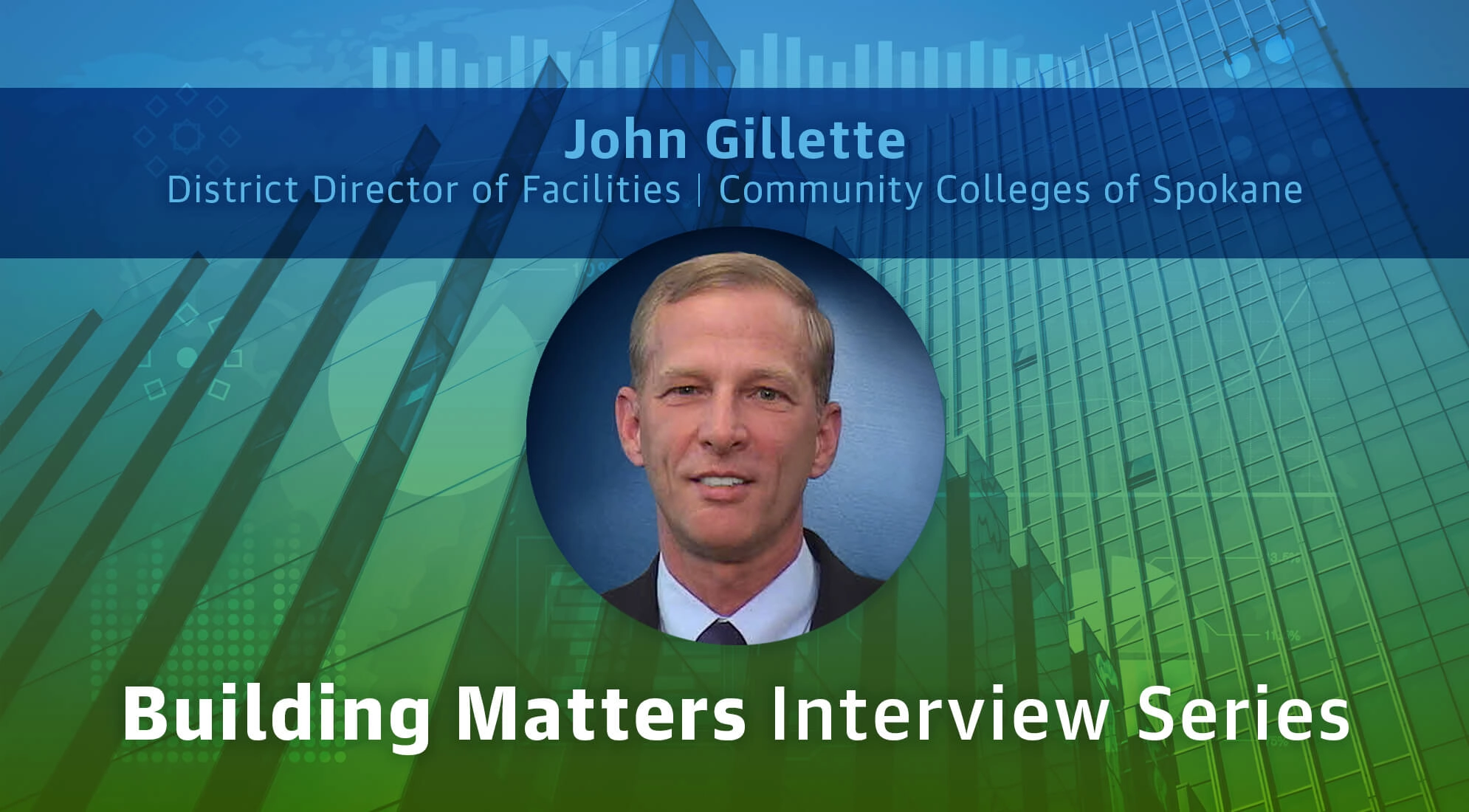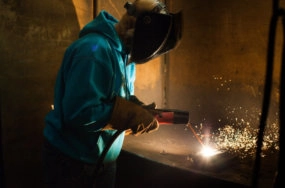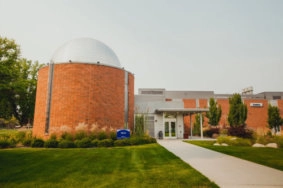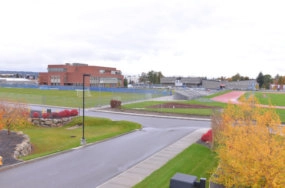
Community College Facilities Insights from John Gillette
December 31, 2024
John Gillette, District Director of Facilities for the Community Colleges of Spokane, is constantly on the hunt for inefficiencies, rooting out waste to make campus run as effectively as possible. In this interview, he discusses how he is driving efforts to improve operations and how data is helping him prepare to lose campus space.
Describe your road to your current role.
I spent 30 years in the Air Force primarily in aircraft maintenance and my last five years I served in various senior leadership roles. My main introduction to facilities came about halfway through my Air Force career. I had the opportunity to work closely with our Civil Engineers in the predesign stage for a few buildings and on installation master planning.
After I retired from the Air Force, I was offered a position with the United States Border Patrol, at the Spokane Sector Headquarters, working in the Logistics Department. One of my jobs was Assistant Facilities Manager and I got a much broader exposure to facilities as a whole. During my time with the Border Patrol, we coordinated with the Army Corps of Engineers to construct three new stations and took care of all the routine maintenance at seven stations spread out from the eastern slopes of the Cascades as far west as Glacier National Park. After a few years, I had an opportunity to move to the Community Colleges of Spokane (CCS) as Director of Maintenance and shortly after that, advanced to District Director of Facilities. I’ve been at CCS for nearly five years now.
What do you like about your work?
I like the challenges and the autonomy to solve problems. A lot of my work in facilities emulates my experiences in the aircraft maintenance world. It’s about data-driven decisions, production and strategic thinking. Instead of managing the health of a fleet of aircraft, I have a fleet of buildings.
What programs are offered by the Community Colleges of Spokane?
We have two accredited colleges, Spokane Falls Community College (SFCC) and Spokane Community College (SCC). Spokane Falls is a transfer college focused on liberal arts and the SCC campus is a career or technical college. Spokane Community College offers degrees in nursing and five certification programs. They train for a lot of trades there—welding, HVAC, hydraulics and diesel repair to name a few.
Can you describe the campuses?
I’ll start with SFCC since it’s the newer of the two colleges. It’s more of a suburban campus, part of Fort George Wright, an old military facility. It’s more secluded, with a lot of trees. When you enter, you get a very warm feeling. We have a lot of newer buildings on the campus, so it’s really a nice atmosphere. We’re still utilizing some of those old fort buildings. Our Board of Trustees meets every month in the old officers’ club that resembles a log cabin. Our maintenance facility is a renovated fort warehouse and the old fort dispensary is our photo lab. Those are unique things about the campus that most people don’t know.
SCC, on the other hand, looks more industrial on the perimeter of the campus. We have a heavy equipment shop where they teach how to repair excavating equipment, trucks, buses and road graders. They’re fascinating to me. One building that was re-purposed years ago was specifically built for combine repair. Although the outer perimeter looks industrial, the inside of the inner quad area has tree-lined sidewalks close to the river. It’s a beautiful space.


CCS’s 30,000+ students have a median age of about 28. Does serving a nontraditional population affect facilities decisions?
We’ve talked about the age of our students frequently over the last several months. Our space utilization study revealed that we’re primarily a morning institution. That’s out of the ordinary for community colleges; most see more traffic in the afternoon and evening, where our traffic dies off. It is possible that our students, because of their higher median age, are attending classes in the morning and then working in the afternoon.
We think about that median age and how it impacts our scheduling. I have been looking at how I could use fewer buildings and expand the use of each building. Rather than starting at 7:30 a.m. and ending at 12:30 p.m., how can I push higher space utilization out to 4 or 5 in the afternoon at a minimum? I need to take into consideration the possible negative academic impact on a student population that favors morning classes.
We often hear that funding is a challenge for higher ed facilities. Has that been the case in your experience?
Our budgets are pretty well set. I can’t advocate to the Board that I need more money than a sister department. That doesn’t work here in the state system. The challenge I have is trying to figure out how to stretch the dollars I am allocated.
My number one way to obtain more funds is through savings from eliminating waste. I hate waste and I see it everywhere. We’re removing waste from services and a portion of what’s saved returns to facilities so we can invest it back into our buildings. I’m turning HVAC systems off earlier and implementing LED lighting projects to save on utility costs. We’ve also optimized trash and recycling pick-up schedules. We’re saving approximately $100,000 every year just by changing trash and recycling pick-up.
What is unique about our approach is that we tackle waste even if there are no specific gains for our department. For example, the utility bill is a District-managed cost, so there’s no monetary gain for facilities if we save resources, but there is something in it for Community Colleges of Spokane. We believe that perspective will move the entire institution forward.
What trends do you see that affect college and university facilities?
One trend I am seeing is declining enrollment. Being in this business for just the last five years, I’ve only seen higher education during an economic boom. Everybody tells me that when the economy slows, we will see a surge in enrollment. I’m a little skeptical because I think we’re in a transitional period where we have more people going to school online. It may be that we don’t need as much brick and mortar space as we have in the past.
I see studies that predict people in the future will be self-educated, that they will have skill sets rather than degrees. I wonder if we’ve really considered whether there will always be a need for formal education. I couldn’t imagine a world without it, but are we thinking strategically enough about how we build our campuses?
There are a lot of theories out there right now, but there’s evidence that online enrollment is growing and the number of people actually coming to schools is on the decline. I’m curious to see if the traditional enrollment trend continues during the next economic downturn.
CCS has a big challenge ahead of it. Can you tell us about that?

Next June, a freeway system is being built through the west side of Spokane Community College. It’s going to take away roughly 10 acres of land, two buildings containing 37,000 square feet of space and nearly 1,000 parking spots. This project has been talked about for the last 20 years and we’re finally here. The state made an offer for the land and construction starts next year. It’s a reality at this point.
Protracted negotiations between state agencies have put us into a time crunch and since compensation is not enough to recreate space in today’s market, we’ve started making contingencies. I follow the motto, “Never waste a crisis.” I knew the freeway was my chance to do a space utilization study after first hearing from another institution that their study turned up two million square feet of excess. That’s the primary reason I engaged Sightlines.
What did you want to learn from the space utilization study?
I’m trying to move functions out of 37,000 square feet and I do not want to build any more space. Finding out how to do that efficiently and effectively was my number one goal.
The second thing I had in mind was a capital project planned for the Spokane Falls Community College. We were going to demolish two buildings and build one. At the time, I was thinking we could tear down a third building as well. In the end, the study didn’t support that theory because the three buildings that I wanted to take down had some of the highest utilization on campus. The study gave me valuable data for Spokane Falls Community College — data I use all the time.
How do you use the space utilization data?
Not a day goes by that I don’t think about the utilization study and weigh it in my decisions and my conversations. Recently, I had an orientation meeting with the new Spokane Falls President and we talked about how the campus could be more effective with its space and I sent her a copy of the report. Now that I have space management information from the report, my goal is to influence as many people as I can to start making strategic decisions.
Have there been any tangible changes as a result of promoting the study?
Both colleges are moving toward a centralized scheduling office. I believe this alone will increase our utilization rate on some buildings and help us conserve resources. We are also actively looking at facility staffing since the space utilization study. We know we’re a morning institution, so we are discussing whether morning is the right time for facilities staff to come in. Should they come in six hours later when classrooms are unoccupied? Another aspect we are considering is if we can leave shifts the same but put underutilized buildings on a different cleaning schedule. Right now, all buildings get the same attention; we might be cleaning a clean building.
Since the study, I’ve presented the data myself, and our Sightlines representatives have come back three or four times at my request to give the presentation to different groups. This is all in an effort to affect change. As you can imagine, there’s territorial space that people do not want to give up. What we’ve tried to do is to create a win-win by capitalizing on our shared interests.
Have you been successful at that?
Yes. The lightbulb came on one day for the deans and department chairs at SFCC. The win-win for them was Guided Pathways, a state program that helps students navigate the degree process, resulting in greater graduation rates. What the president and leadership have been hearing is there is no space to expand the program into our campuses. But when they saw the data, they saw there was plenty of space. That allowed SFCC to serve a greater student population. A win-win!
How are you feeling about the impending highway project?
We have a good plan in place. I’m confident that when all is said and done, and the freeway comes through Spokane Community College, we’ll be successful, and people will have their needs accommodated without creating any artificial space. Sightlines has provided the data we need to maximize existing space and allow us to steward our limited resources with excellence.
Share this:





